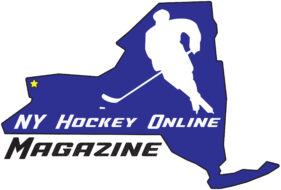BROOKLYN, NY, December 27, 2016 – The National Women’s Hockey League today announced its Policy on Participation of Transgender Athletes, which goes into effect immediately.
As stated in the Purpose section of the policy, “The NWHL recognizes all forms of gender expression. Therefore, the NWHL supports athletes choosing to express their gender beyond the binary of female and male.” The policy includes eligibility guidelines in order to ensure a fair and level playing field for all participants.
The policy was created by the NWHL in partnership with the You Can Play Project and with additional counsel from policy and law advisors from the National Center for Lesbian Rights (NCLR).
“This is an opportunity to move the conversation forward and accelerate social progress,” said NWHL Commissioner Dani Rylan. “The NWHL wants to be a reference point and resource for the next player or league that may feel uncertain or underprepared for their moment.”
Founded in 2012, the You Can Play Project works to ensure the safety and inclusion of all in sports, including LGBTQ athletes, coaches and fans. The San Francisco-based NCLR shapes the legal landscape for all LGBT people and families across the nation through its precedent- setting litigation, legislation, policy, and public education.
“You Can Play is proud to partner with the NWHL to create the most inclusive policy in women’s professional sports,” said Chris Mosier, Vice President, Program Development & Community Relations. “It comes down to respect – when we respect a player’s identity, name, and pronoun, we are creating a space where athletes can show up as their authentic self, allowing them to be better players, teammates, and leaders.”
Please see the NWHL’s Policy on Participation of Transgender Athletes below.
National Women’s Hockey League Policy on Participation of Transgender Athletes
December, 2016
The National Women’s Hockey League (NWHL) is committed to creating safe and inclusive spaces while maintaining competitive equity in women’s professional hockey.
Guiding Principles
The NWHL will use the following principles to determine eligibility for tryouts and play in accordance with this policy:
- a) This policy exists to reassure transgender athletes of the protections and support they have, both within law and within the NWHL policies and protocols.
- b) The implementation and administration of this policy will consider a fair and equitable level of monitoring that is respectful, inclusive, and respects a person’s human rights.
- c) This policy may be modified, updated, or otherwise changed pending updated medical and expert information.
Purpose
The NWHL recognizes all forms of gender expression. Therefore, the NWHL supports athletes choosing to express their gender beyond the binary of female and male. The NWHL will use the eligibility guidelines set out in this policy in order to ensure a fair and level playing field for all participants.
Eligibility Guidelines
Considering the most up-to-date medical and expert information available at the time of the implementation of this policy, participation is open to:
- People designated female at birth, regardless of their gender identity.
1.1 The athlete may not take testosterone hormone therapy. Athletes transitioning to male who undergo hormone therapy will be ineligible to compete.
- Those who transition from male to female are eligible to compete under the following conditions:
2.1. The athlete has declared that her gender identity is female. The declaration cannot be changed, for sporting purposes, for a minimum of four years.
2.2. The athlete must demonstrate that her total testosterone level in serum is within typical limits of women athletes.
2.3. The athlete’s total testosterone level in serum must remain in the typical range of women athletes throughout the period of desired eligibility to compete in the female category.
2.4. Compliance with these conditions may be monitored by testing. In the event of non-compliance, the athlete’s eligibility in the league will be suspended for 12 months.
Process
An athlete may initiate the process by contacting the NWHL prior to try-outs outlining their wish to participate in accordance to the NWHL’s Transgender Athlete policy. The NWHL may, with a credible basis for believing that the athlete is asserting a transgender identity for an improper purpose, ask for additional information before moving forward with registration. Upon review of information and if it is deemed sufficient, the athlete will immediately be eligible to try out or compete if offered a position, and will continue to do so unless circumstances dictate that another gender declaration should be made.
Athletes currently participating in the NWHL who wish to make changes to their gender identity, name, pronoun, or other markers within the league should contact the NWHL to assist in making these changes on official publications and listings.
Confidentiality
All of the information and documents related to the eligibility of a transgender athlete will be treated as highly confidential. The Parties agree that they will not at any time disclose that information or documents (other than in the ordinary and usual course of implementing this policy) without the prior written consent of the disclosing party, unless required by law.
Definitions:
- a) Gender identity is each person’s sense of belonging to a particular gender, such as woman, man, both, neither, or anywhere along the gender spectrum. Current science recognizes that gender identity is innate or fixed at a young age and strongly indicates that gender identity has a biological basis. A person’s gender identity may be the same as or different from their birth-assigned sex. When a person’s gender identity is different from that person’s birth-assigned sex, gender identity is determinative of that person’s sex.
- b) Gender expression is how a person publicly presents their gender. This can include behavior and outward appearance such as dress, hair, make-up, body language and voice. A person’s chosen name and pronoun are also common ways of expressing gender.
- c) Trans or transgender is a term that refers to a person whose gender identity, or affirmed sex, that is different from the sex they were assigned or assumed to be at birth.







